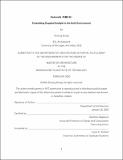Komorebi : embedding dappled sunlight in the built environment
Author(s)
Zhang, Zhujing(Researcher in architecture) ArchMassachusetts Institute of Technology.
Download1237109786-MIT.pdf (5.594Mb)
Alternative title
Embedding dappled sunlight in the built environment
Other Contributors
Massachusetts Institute of Technology. Department of Architecture.
Advisor
Takehiko Nagakura.
Terms of use
Metadata
Show full item recordAbstract
Humans are increasingly disconnected from nature. Urbanization, resource exploitation, and changes in ways of living have diminished people's access to nature. Exposure to nature is beneficial to human beings in many aspects. Researches in environmental psychology and public health have shown the positive impacts of nature connections for people's happiness, concentration, and restoration. In creating the living environment with the connectedness to nature, various researches have been invested, such as the study of green space in the living environment, the application of virtual nature in psychiatric and medical care, the implementation of natural scenery in augmented reality. However, the idea of imitating natural phenomena in the built environment via tangible building systems has not been explored yet. This thesis aims to provide people with the perception of connectedness to nature in the built environment by embedding the sensory experience of nature, Komorebi, in the building system. Komorebi is a Japanese term that describes the dappled sunlight filtered through tree foliage. Through analysis of this visual effect and experimenting with various materials and actuators, a daylight-filtering system is developed to bring the dappled light phenomenon into the built environment. Environmental performance simulations of the Komorebi system is conducted in comparison with no-shading and the Venitian blind. The system builds on the existing infrastructure to integrate elements of improvisational nature into the building system, creating natural sensory experiences in the built environment. In practice, it would have great potential at places where natural connections are limited, and relinking occupants to nature would be highly beneficial. The impact of this work includes 1) creating a port for people who have limited access to nature due to work demand or mobility limitation, 2) invoking people's memories in nature, and encouraging more exposure to nature.
Description
Thesis: M. Arch., Massachusetts Institute of Technology, Department of Architecture, February, 2020 Cataloged from student-submitted thesis. Includes bibliographical references (pages 45-47).
Date issued
2020Department
Massachusetts Institute of Technology. Department of ArchitecturePublisher
Massachusetts Institute of Technology
Keywords
Architecture.